How to Get Rid of Fungus Gnats - Quickly & Permanently
Author: Jen Worst | Editor: Omar Alonso
Review & Research: Jen Worst & Chris Miller
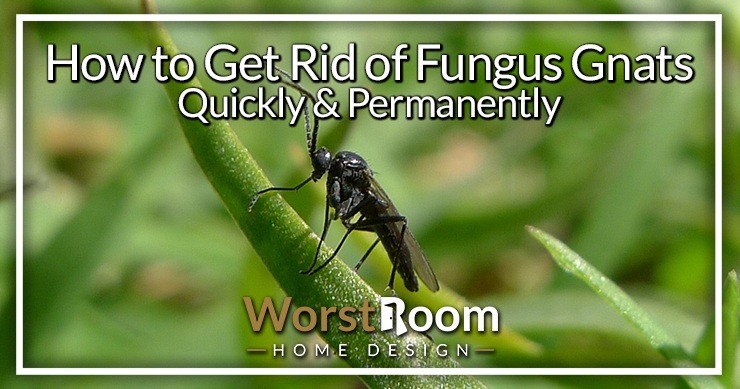
As you can guess, I'm writing about how to get rid of fungus gnats because it's a plan I'm enacting right now. I realized it last night as my cat was trying to catch something at the window only for it to end up on my computer screen.
They've managed to create a home out of my houseplants and I'm guessing they're laying eggs in the soil, too. As always, when I deal with an issue I try to write about it, not only so I can reference it later but so I can share it with the world.
So let me tell you how to get rid of these pests, what causes them, and how to prevent it from happening again.
I'll also cover some frequently asked questions about these types of gnats and give you some basic information about them and their lives. Thankfully, you'll find it isn't that hard to rid yourself of them and rather quick.
How to Get Rid of Fungus Gnats
The first move is to get rid of the adults to stop the laying of any new eggs. After that, you'll want to deal with any larvae growing in your houseplant soil. These steps also work for the outdoors, but dealing with the larvae consistently is more important.
The key here is consistency. The adults will grow from the larvae in waves and you need to be prepared to deal with several cycles. Our plan of attack is:
- Traps for the flying and walking adults
- Prevention and life cycle disruption for the larvae
Here are some methods with dealing with the adults first.
Yellow Sticky Card Traps - You can find sticky card traps at Amazon for cheap and are extremely effective because you can place them right onto the soil where the adults are walking around. Many come with guiding lines so you can cut them into tiny squares, which I recommend doing.
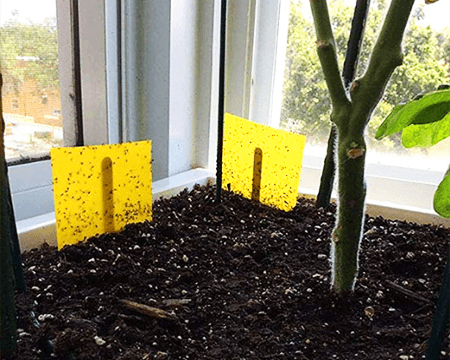
You can lay these small squares sticky side up on the soil (and if you want, stick them down with toothpicks). The adults will walk right onto them and that's game over for them.
Make sure you go with yellow traps because the fungus gnat is attracted to yellow. Typical flypaper can work too if you already have it.
Cider, Vinegar, & Soap Traps - Most people are familiar with this classic home remedy method. My mom had them scattered in different window sills all the time.
Basically, you take a shallow dish like a small sauce serving bowl or tuna can that's around a 1/2 an inch deep and fill it with a custom mixture.
Take equal parts of apple cider vinegar and water and mix them up. You need enough to create at least a 1/4 of an inch in liquid depth. This serves as the bait.
Then you place a few drops of liquid dish soap into it and stir lightly. Don't create a bubbly mess. You just want to create a sticky solution that doesn't have enough surface tension to carry the fungus gnats.
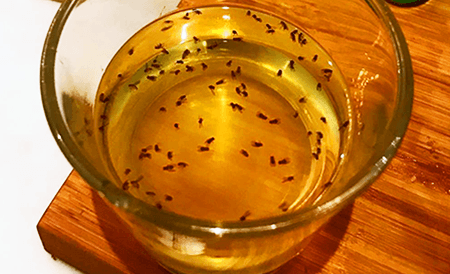
Place this trap directly onto the soil of the affected houseplant and the adults will fly right into it. Refresh the water and cider vinegar every few days and keep it in place for a few weeks.
Diatomaceous Earth - This is extra cruel but it works great. Dust the surface of the soil of the affected plant with diatomaceous earth, paying extra attention to the inside of the outer edges of the pot and around the base of the stem.
This is a reasonable method if you're trying to cover a lot of ground outdoors.
This gets on the gnats and absorbs moisture from them, effectively dehydrating them. It also gets into their joints and causes internal injuries. The only problem with this method is when you water the plants you'll wash away most of the diatomaceous earth.
If you can water from the bottom then that's fine. Otherwise remember to add more powder after watering and drying.
Now we need to discuss the problem of the eggs and larvae that are already hatching and growing into more adults.
Mosquito Dunks - This is really the only method to take care of the larvae. A mosquito dunk comes as a dry pellet that you'll dissolve into water that you'll pour over and through the soil of your plant.
The pellet is reusable, so you can either break off pieces of it or let it partially dissolve before removing it for another use later.
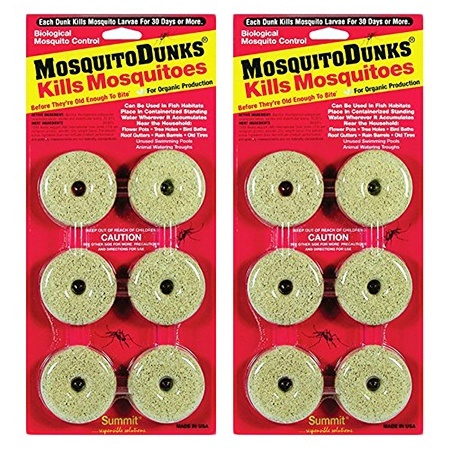
The pellet contains a bacteria called Bacillus thuringiensis, a subspecies of isrealensis. Larvae of flying insects get infected with it, leading to their passing into bug heaven.
You'll want to use this pellet solution for two or three months if you want to be extra thorough, though two or three times total seems to do the trick.
This insecticidal soap lasts for a long time once permeated into the soil. As a preventative measure you only need to do this once a year after the initial treatment.
There are kinds that employ an insect growth regulator called diflubenzuron that only lasts for one to two months as the active ingredient, so be aware of what you use.
You can use products like neem oil, hydrogen peroxide, cinnamon, and AzaMax but in this case you're better off with mosquito dunks. Those products are used for getting rid of spider mites and insects that lay their eggs and hatch larvae above ground.
How to Prevent Fungus Gnats
Of course, once you get rid of your fungus gnat problem, you'll want to do what you can to prevent it the next time. Thankfully these are very passive methods that take nearly zero effort the first time and then you don't have to do anything else.
Inspect Plants Before Purchase - If you see any fungus gnats fly up when handling the potted plant, reject it and those around it. You can turn up an inch or two of soil and see if you can find any larvae.
Let Your Soil Dry Out - The first thing you can do is make sure you allow more time to pass between waterings of your plants.
Fungus gnats like to lay their eggs in moist soil, so if the top is too dry for their taste, they'll move on to another location (or die of old age in your window sill). Just pinch the top inch of your soil occasionally to check dryness.
Add a Layer of Sand - Another way to keep your soil dry is to place about a 1/2 of an inch of coarse sand across the top of your soil. It's not the prettiest solution but it drains quickly so adult gnats won't be tempted to lay eggs.
It also helps stop growing larvae from every being able to emerge out of the soil and through the sand. The annoyance with this is you'll need to start watering from the bottom of your container so you don't wash the sand away.
Cover the Drainage Holes - If you're taking care of the top portions of the soil as mentioned above, fungus gnats will still seek out the moist drainage holes, so you need to cover them too.
You just need some kind of synthetic fabric that won't rot to cover the holes but still let water pass through. You can keep it in place with glue, tape, or rubber bands.
If you're really proactive, you can do the occasional mosquito dunk as mentioned above.
Keeping that bacteria around in the soil will stop these pesky buggers from going through their life cycle in your potted plants, which means no adults flying around and no larvae harming the roots of your plants.
The Fungus Gnat Predator - If you're dealing with a large scale garden, good decision is to introduce a predator into the mix. The Stratiolaelaps scimitus seeks out fungus gnat larvae and other insects.
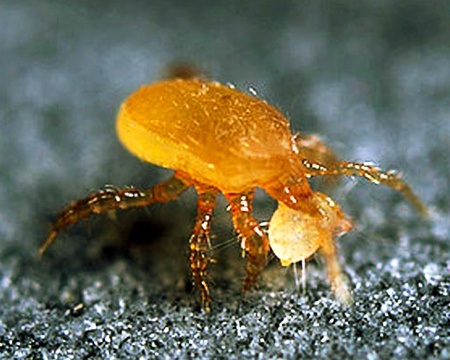
You can order them in bottles that contain as many as 25,000 of these mites, which trips me out. I think about what would happen if a bottle busted open during shipping. I don't recommend using these or any beneficial nematodes in your house.
Causes of Fungus Gnat Infestation
Knowing how to kill fungus gnats is easy, but it's better off to prevent them altogether. Part of doing that is understanding what causes an infestation in the first place.
Fungus gnat eggs are generally planted in overly moist soil, though outdoors they're known to even use moist, rotting wood. If it's moist and has fungus growing, especially in topsoil, they like it.
Early intervention is the key to preventing an outbreak. If you see adults flying around in any significant numbers you need to act in the ways mentioned above, and quickly since their life cycle is so fast.
You need to get rid of the adults and stop eggs from hatching and larvae from developing all at once, otherwise multiple generations can grow while you're just dealing with the adults over and over.
The cause of an infestation indoors and outdoors is simply a lack on your part to attack at least two stages of the life cycle (eggs, larvae, and adults) to put an end to the replication.
What are Fungus Gnats?
Fungus Gnats make up 6 of the 7 families in the superfamily Sciaroidea. They can be helpful because they aid in the decomposition of organic matter, like in compost. They're typically just annoying, but there are predator types in the Arachnocampa genus in the Keroplatidae family.
The are also pollinators and even can aid in the spreading of mushroom spores.
The main problem associated with them is they (mainly in the Sciaridae family) carry diseases that are particularly deadly to plants, such as pythium, which causes a condition called damping-off, as mentioned below.
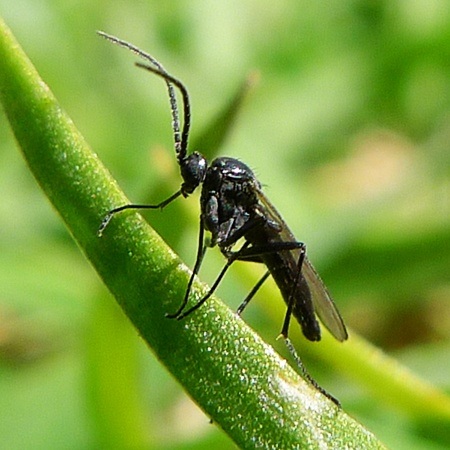
Unlike other pests, you can find these year-round due to their bodily make-up including antifreeze proteins that makes them exceptionally tolerant of cold weather.
How to Identify Fungus Gnats
You want to make sure you're dealing with fungus gnats and not fruit flies. First let's talk about their activity levels. This will help you make sure you're dealing with the right pest and employing the right methods to exterminate them in the present and prevent them in the future.
Activity Levels & Location
You'll typically find fruit flies in the kitchen, in your banana bags, coming out of your trashcans, and often in the garbage disposal and sink pipes (flush those out ASAP with dish soap). Be careful what you use to clean up so you don't corrode any seals and end up with a garbage disposal leaking from the bottom.
Fungus gnats will fly around the home but usually stay in the room where your plants are and very close to those plants, which they turn into their own homes.
They'll lay eggs in your houseplant soil, and that's why they tend to stay close, though they'll get distracted by light like any insect will.
So you might see them around the windows, your TV or computer monitor, and around lightbulbs, too. But most often they stick to the plants and soil.
They'll walk around a lot and only occasionally fly around because they can't do it for long periods of time. When they do fly, they dart around a lot more than fruit flies do, and will explore the area in front of your face and around your sugary and sweet drinks.
Size & Appearance
The adult fungus gnat is what you'll notice. You'll find that they're small, as tiny as a fruit fly at about 1/16th to 1/8th of an inch in length. If you can see their larvae, you'll find they're around 1/8th of an inch long.
The adult has a dark gray to black color. Their wings are partially transparent, allowing you to see through them and their gray color. The larvae have a thin body, usually white or a pale see-through complexion. The larvae have a small black head at the tip of the body.
When you think about a fruit fly they tend to have a rounder shape overall, while fungus gnats are more like mosquitos in appearance but smaller. They have long legs and antennae and a thin body.
Fungus Gnat Life Cycle
What's nice is the adult fungus gnat only lives around one week, but in that time they can lay up to 300 eggs each. In about 4-6 days these eggs hatch into larvae and begin snacking on the roots of your plants in the moisture rich soil.
The pupal larvae grow into adults within 3-4 days and repeat the cycle. As you can imagine, the population can explode exponentially pretty fast.
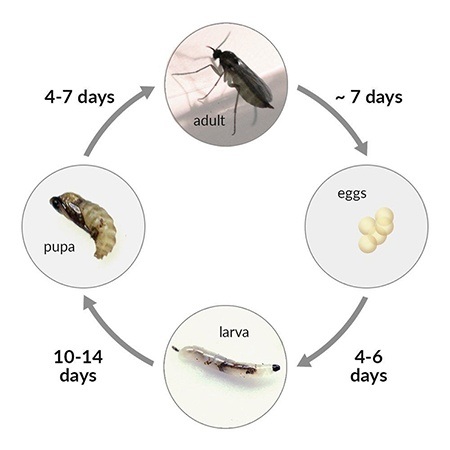
The whole life cycle from laying of the eggs to adults dying off of old age takes place in 3-4 weeks total, with the range changing depending on the local temperature. This entire life cycle can occur in a single potted plant, hosting several generations at once!
The Damage They Cause
In most cases, especially indoors, fungus gnats are harmless. They're extremely annoying but won't harm you or your plants in normal numbers. If you allow them to thrive inside to grow a large enough colony to harm your plants, you've got bigger problems than gnats.
In extremely large numbers, the fungus gnat larvae can eat enough of the roots of your plants to cause significant stress and hurt their ability to thrive and grow. This is particularly important if you're dealing with seedlings, cuttings, and young plants.
They also carry a pathogen caused by fungi that they like, such as Phtophtora and Pythium.
When spread to your plants, this causes a condition called "damping-off," which causes a thinner, constricted stem that causes the plant to be too top-heavy. It will fall over eventually and die. Please note that damping-off can't be cured, only prevented.
Compost and peat moss as a potting mix is particularly easy to be affected by the damping-off fungus, so consider moving to a perlite or vermiculite mix instead.
Plants that are more easily harmed by fungus gnats are spider plants, wandering jew, types of geraniums, african violets, and peace lilies, so take extra care if you're growing these. You'll know there's a problem if you start seeing poor growth, yellowing, and sudden wilting.
Fungus Gnats: Frequently Asked Questions
Below are a handful of the most common questions I ran into when researching this topic:
How to Get Rid of Fungus Gnats Outside?
The best method for the outdoors involves either introducing predatory mites into the area or diatomaceous earth onto and into the soil. Diatomaceous earth is not recommended due to the damage it can cause to the rest of the insect population.
The same goes for insecticidal soaps.
What Kills Fungus Gnats and Their Larvae?
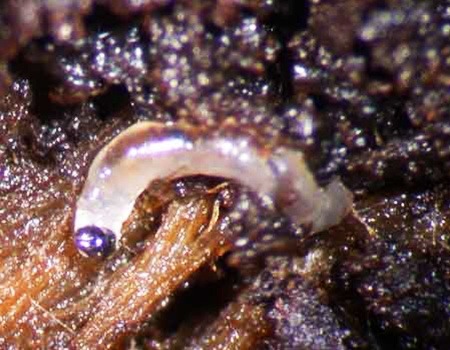
The best method to kill the adults is through sticky traps or liquid traps. The larvae are best dealt with using a larvicide, which usually involves a bacteria that causes an infection that destroys them before they grow into adults.
How Long do Fungus Gnats Live?
Their entire life cycle from egg laying to adult old age is 3-4 weeks in length. As an adult, they live for about 7 days, but not before laying as many as 300 eggs per female and spreading rapidly.
What is the Fastest Way to Get Rid of Fungus Gnats in Your House?
Sticky traps quickly reduce the adult population and stop them from laying more eggs. Mosquito dunks spread a bacteria to the larvae and eggs to stop their development into adults. This is the fastest method.
Do Fungus Gnats Die in Winter?
Fungus gnats' bodies contain what are called antifreeze proteins which make them especially hardy when it comes to cold temperatures. The larvae can survive freezing, though may suffer some tissue damage in their heads and "tails."
Otherwise, they continue their normal life cycle of birth to death in 3 to 4 weeks.
Will Fungus Gnats Go Away on Their Own?
If they consume their entire food source (typically fungus around and the actual roots of plants) the colony can die of starvation. Otherwise, like outdoors, they can thrive for long periods of time before naturally migrating to other locations.
Direct action is encouraged to get rid of fungus gnats, as opposed to hoping they leave on their own, due to their rapid replication.
Does Dish Soap Kill Fungus Gnats?
Dish soap is typically used in cider vinegar traps, causing any adult fungus gnats that land on it to sink, due to the decrease in surface tension that allows them to stand on top of pure water.
The soap itself is not an effective means of harming the gnats biologically, other than drowning.
Getting Rid of Fungus Gnats is Easy!
The hardest part about getting an infestation of fungus gnats is learning to deal with them. Getting rid of them and preventing them is pretty simple, so the whole thing becomes quite the relief.
You just have to go through the process, which is a piece of cake. And then you'll have supplies on hand for (god forbid) next time.



